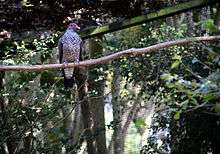Scaled pigeon
The scaled pigeon (Patagioenas speciosa)[2] is a large New World tropical dove. It is a resident breeder from southern Mexico south to western Ecuador, southern Brazil, northern Argentina, and Trinidad.
| Scaled pigeon | |
|---|---|
 | |
| At Zooparque Itatiba, Sao Paulo State, Brazil | |
| Scientific classification | |
| Kingdom: | Animalia |
| Phylum: | Chordata |
| Class: | Aves |
| Order: | Columbiformes |
| Family: | Columbidae |
| Genus: | Patagioenas |
| Species: | P. speciosa |
| Binomial name | |
| Patagioenas speciosa (Gmelin, 1789) | |
| Synonyms | |
|
Columba speciosa Gmelin, 1789 | |
The scaled pigeon is fairly common in semi-open forest. It builds a stick platform nest in a tree and lays two white eggs.

Its flight is high, fast and direct, with the regular beats and an occasional sharp flick of the wings which are characteristic of pigeons in general. It is usually very wary, since it is frequently hunted.
The scaled pigeon is 36 cm (14 in) long and weighs normally about 290 g (10 oz). Adult males have mainly purple brown plumage, with a paler scaly appearance to the neck and underparts. The lower underparts are whitish edged with purple. The eyering, legs and bill are red, the latter having a white tip. The female is dull dark brown rather than purplish, and is slightly smaller than the male.
Scaled pigeons feed mainly on forest fruits and seeds. The call is a series of deep cooing cro ku-ks that differs markedly from that of its relatives, such as the white-crowned pigeon.[3] This is a solitary bird which does not form flocks.
The scaled pigeon has been recorded as successfully nesting on a fern (Pteridium aquilinum at ground level, and in the canopy of the tree fern Cyathea cyatheoides). The pearl kite visits nests of this species as a natural predator.[4]
References
- BirdLife International (2012). "Patagioenas speciosa". IUCN Red List of Threatened Species. 2012. Retrieved 26 November 2013.CS1 maint: ref=harv (link)
- Johnson, Kevin P.; de Kort, Selvino; Dinwoodey, Karen, Mateman, A. C.; ten Cate, Carel; Lessells, C. M. & Clayton, Dale H. (2001): A molecular phylogeny of the dove genera Streptopelia and Columba. Auk 118(4): 874-887. PDF fulltext
- Mahler, Bettina & Tubaro, Pablo L. (2001): Relationship between song characters and morphology in New World pigeons. Biol. J. Linn. Soc. 74(4): 533–539. doi:10.1006/bijl.2001.0596 (HTML abstract)
- Aguilar, Héctor F. (1996)- Algunas Notas Sobre la Paloma Leona Columba [speciosa] speciosa Gmelin 1789 (Aves: Columbidae) en Mérida, Venezuela. Zoocriaderos 1(2):25-34
- ffrench, Richard; O'Neill, John Patton & Eckelberry, Don R. (1991): A guide to the birds of Trinidad and Tobago (2nd edition). Comstock Publishing, Ithaca, N.Y.. ISBN 0-8014-9792-2
- Hilty, Steven L. (2003): Birds of Venezuela. Christopher Helm, London. ISBN 0-7136-6418-5
- Stiles, F. Gary & Skutch, Alexander Frank (1989): A guide to the birds of Costa Rica. Comistock, Ithaca. ISBN 0-8014-9600-4
